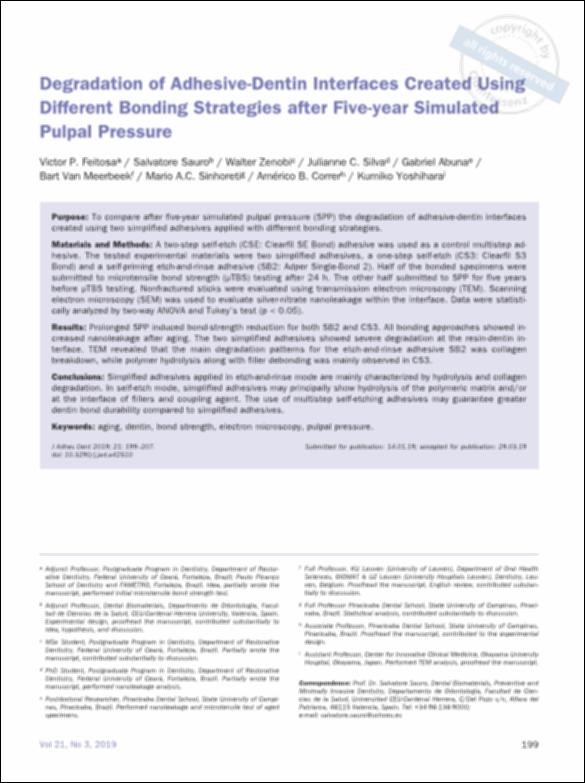Por favor, use este identificador para citar o enlazar este ítem:
http://hdl.handle.net/10637/11655Degradation of adhesive-dentin interfaces created using different bonding strategies after five-year simulated pulpal pressure
| Título : | Degradation of adhesive-dentin interfaces created using different bonding strategies after five-year simulated pulpal pressure |
| Autor : | Feitosa, Victor Pinheiro Sauro, Salvatore. Zenobi, Walter Silva, Julianne C. Abuna, Gabriel Meerbeek, Bart van Sinhoreti, Mario A.C. Correr, Américo B. Yoshihara, Kumiko |
| Materias: | Cementos dentales.; Materiales dentales.; Dental materials.; Dentin.; Dental cements.; Adhesivos dentales.; Dentina.; Dental adhesives. |
| Editorial : | Quintessenz. |
| Citación : | Feitosa, VP., Sauro, S., Zenobi, W., Silva, JC., Abuna, G., Meerbeek, BV., et al. (2019). Degradation of adhesive-dentin interfaces created using different bonding strategies after five-year simulated pulpal pressure. The Journal of Adhesive Dentistry, vol. 21, n. 3, pp. 199-207. DOI: https://doi.org/10.3290/j.jad.a42510 |
| Resumen : | Purpose: To compare after five-year simulated pulpal pressure (SPP) the degradation of adhesive-dentin interfaces created using two simplified adhesives applied with different bonding strategies. Materials and Methods: A two-step self-etch (CSE: Clearfil SE Bond) adhesive was used as a control multistep adhesive. The tested experimental materials were two simplified adhesives, a one-step self-etch (CS3: Clearfil S3 Bond) and a self-priming etch-and-rinse adhesive (SB2: Adper Single-Bond 2). Half of the bonded specimens were submitted to microtensile bond strength (μTBS) testing after 24 h. The other half submitted to SPP for five years before μTBS testing. Nonfractured sticks were evaluated using transmission electron microscopy (TEM). Scanning electron microscopy (SEM) was used to evaluate silver-nitrate nanoleakage within the interface. Data were statistically analyzed by two-way ANOVA and Tukey’s test (p < 0.05). Results: Prolonged SPP induced bond-strength reduction for both SB2 and CS3. All bonding approaches showed increased nanoleakage after aging. The two simplified adhesives showed severe degradation at the resin-dentin interface. TEM revealed that the main degradation patterns for the etch-and-rinse adhesive SB2 was collagen breakdown, while polymer hydrolysis along with filler debonding was mainly observed in CS3. Conclusions: Simplified adhesives applied in etch-and-rinse mode are mainly characterized by hydrolysis and collagen degradation. In self-etch mode, simplified adhesives may principally show hydrolysis of the polymeric matrix and/or at the interface of fillers and coupling agent. The use of multistep self-etching adhesives may guarantee greater dentin bond durability compared to simplified adhesives. |
| Descripción : | El resumen de este artículo se encuentra disponible en la página web de la revista en la siguiente URL: https://jad.quintessenz.de/index.php?doc=abstract&abstractID=42510/ |
| URI : | http://hdl.handle.net/10637/11655 |
| Derechos: | http://creativecommons.org/licenses/by-nc-nd/4.0/deed.es |
| ISSN : | 1461-5185 1757-9988 (Electrónico) |
| Fecha de publicación : | 7-jun-2019 |
| Centro : | Universidad Cardenal Herrera-CEU |
| Aparece en las colecciones: | Dpto. Odontología |
Los ítems de DSpace están protegidos por copyright, con todos los derechos reservados, a menos que se indique lo contrario.


